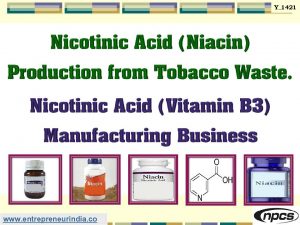Nicotinic Acid (Niacin) Production from Tobacco Waste

Nicotinic Acid (Niacin) Production from Tobacco Waste. Nicotinic Acid (Vitamin B3) Manufacturing Business
Niacin (nicotinic acid) is used to prevent and treat niacin deficiency (pellagra). Niacin deficiency may result from certain medical conditions (such as alcohol abuse, malabsorption syndrome, Hartnup disease), poor diet, or long-term use of certain medications (such as isoniazid).
Niacin cannot be directly converted to nicotinamide, but both compounds are precursors of the coenzymes nicotinamide adenine dinucleotide (NAD) and nicotinamide adenine dinucleotide phosphate (NADP) in vivo. NAD converts to NADP by phosphorylation in the presence of the enzyme NAD+ kinase. NADP and NAD are coenzymes for many dehydrogenases, participating in many hydrogen transfer processes. NAD is important in catabolism of fat, carbohydrate, protein, and alcohol, as well as cell signaling and DNA repair, and NADP mostly in anabolism reactions such as fatty acid and cholesterol synthesis.
High energy requirements (brain) or high turnover rate (gut, skin) organs are usually the most susceptible to their deficiency. Although the two are identical in their vitamin activity, nicotinamide does not have the same pharmacological effects (lipid modifying effects) as niacin. Nicotinamide does not reduce cholesterol or cause flushing. As the precursor for NAD and NADP, niacin is also involved in DNA repair.
Market Outlook
The global market for nicotinic acid (Vitamin B3) will grow at a CAGR of 5.2% by 2022. In 2017, the global Niacin market is led by China, capturing about 46.69% of global Niacin production. India is the second-largest region-wise market with 22.66% global production share. Niacin is a one of the water-soluble B vitamins. Niacin is referred as a nicotinic acid and nicotinamide. These two nutrients help to body to convert food into glucose and also help to produce energy. Most of physicians prefer Niacin to treat nervous system and to normalize the psychological function. In addition to this Niacin has been used to fortify grains such as corn and bran breakfast cereals and wheat flour.
In application, Niacin downstream is wide and recently Niacin has acquired increasing significance in various fields of Feed Additives, Pharmaceuticals and Cosmetics and Food and Beverage. Globally, the Niacin market is mainly driven by growing demand for Feed Additives which accounts for nearly 77.65% of total downstream consumption of Niacin in global. In type, Niacin can be divided into feed grade and Pharmaceutical Grade. Feed grade is the largest type, holding about 93.29% share.
The increasing prevalence of cardiovascular diseases is estimated to serve as one of the major drivers for the nicotinic acid market. Cardiovascular diseases are the number one cause of death all across the world. In 2017, around 31% of global death were due to cardiovascular diseases. The increase in the occurrence of cardiovascular diseases has increased awareness among consumers. The consumers are taking appropriate measures to maintain a healthy lifestyle. Thus, the demand for cholesterol-reducing ingredients is anticipated to increase in the food and dietary supplement industry.
Thus, nicotinic acid serves as a suitable option as it helps to reduce bad cholesterol, which further reduces the risk of cardiovascular diseases. Also, nicotinic acid is available in liquid as well as powder form which makes it easy for the manufacturers to develop healthy products according to their requirements.
The increase in health-awareness among the consumers is anticipated to have a positive impact on the nicotinic acid market. Consumers are adopting new habits to improve their health. The demand for dietary supplements is increasing among consumers. The consumer prefers the consumption of dietary supplements to fulfill the daily nutritional requirements of the body. Nicotinic acid offers many beneficial properties such as it might prevent help to treat Type 1 Diabetes, increases HDL levels, treats pellagra, etc. The demand for vitamin supplements is increasing.
The niacin market can be segmented based on the basis of application, nutrition type and form. On the basis of application the niacin market can segmented into Pharmaceutical, Personal Care Products, Agricultural, and Live Stock. On the basis of nutrition type the niacin market can be categorized into human nutrition, and animal nutrition. Moreover, the niacin mix market can be segmented on the basis form including liquid and solid form.
Geographically, the global market for niacin market can be segmented into seven regions, namely North America, Latin America, Europe, CIS & Russia, and Asia Pacific excluding Jap The increase in health and fitness trends in the Asia Pacific region is estimated to boosts the sales of nicotinic acid. The impact of western culture, increase in disposable income, hectic lifestyle, and high youth population is some of the drivers for the increase in the demand for nicotinic acid.
The high youth population and their inclination towards the gym and other fitness activities enhance the requirements of vitamins and proteins. Thus, the manufacturers of the dietary supplement industry are anticipated to develop dietary supplements which contain multivitamins and other essential nutrients that are required by the youth population. Therefore, the demand for nicotinic acid is anticipated to increase in the Asia Pacific region. an, Japan and Middle East & Africa.
Key Players in this Nicotinic Acid (Vitamin B3) market are:
- Aarti Drugs
- Brother Enterprises Holding
- DSM
- Jubilant Life Science
- Lanbo Biotechnology
- Lasons
- Lonza
- Nantong Acetic Acid Chemical
- Red Sun Group
- Resonance Specialties
- Tianjin Zhongrui Pharmaceutical
- Vanetta
- Vertellus
See more